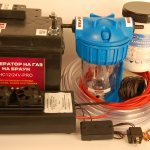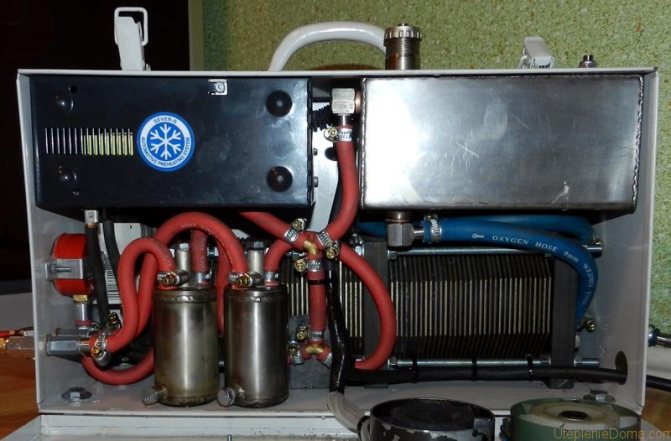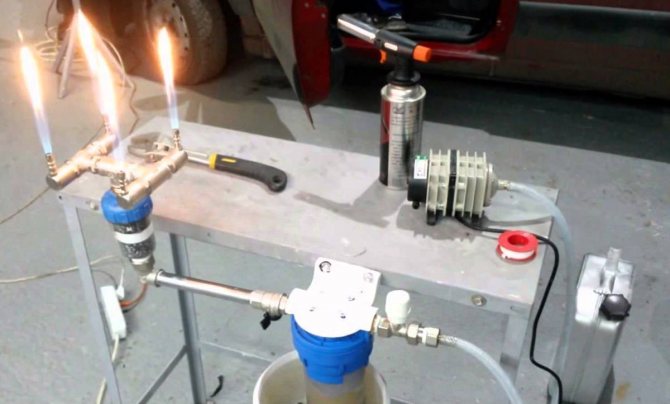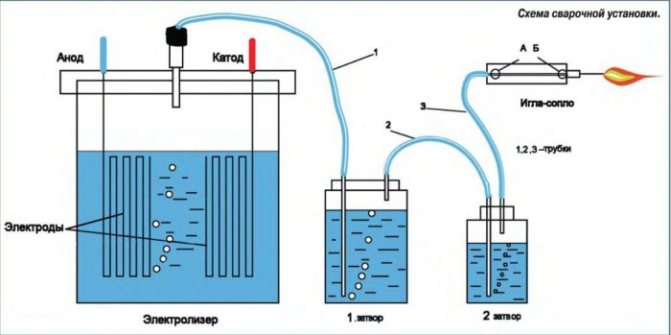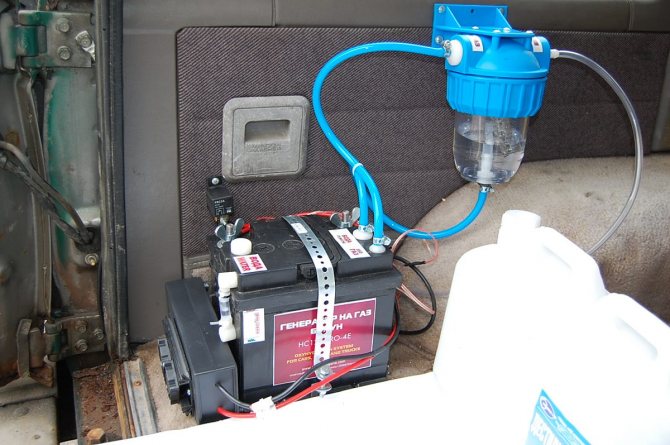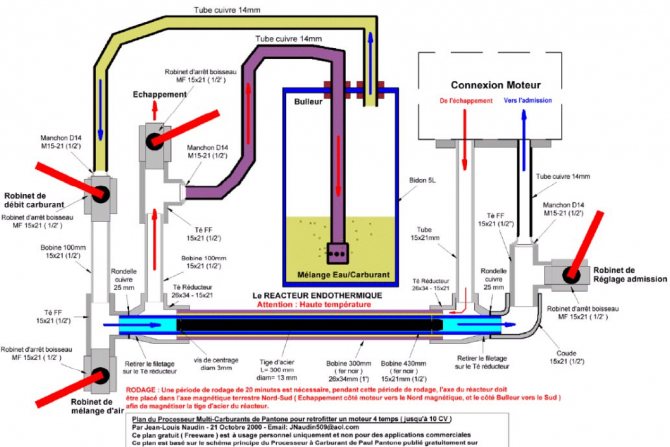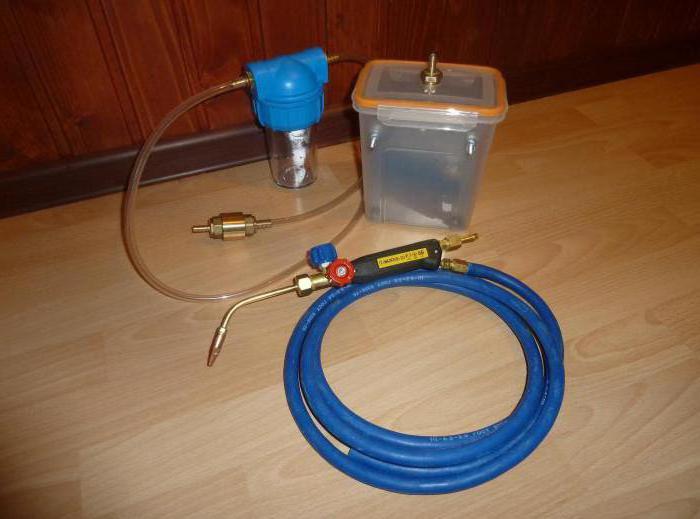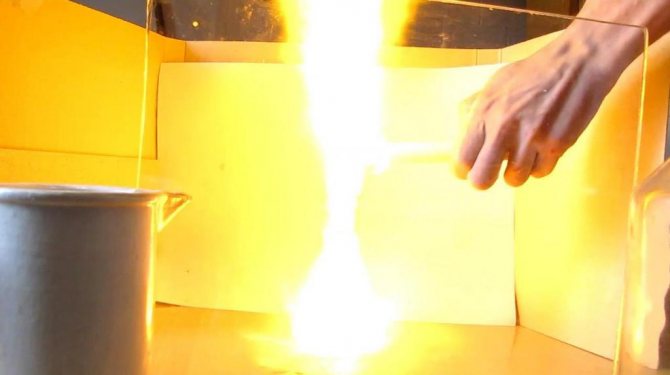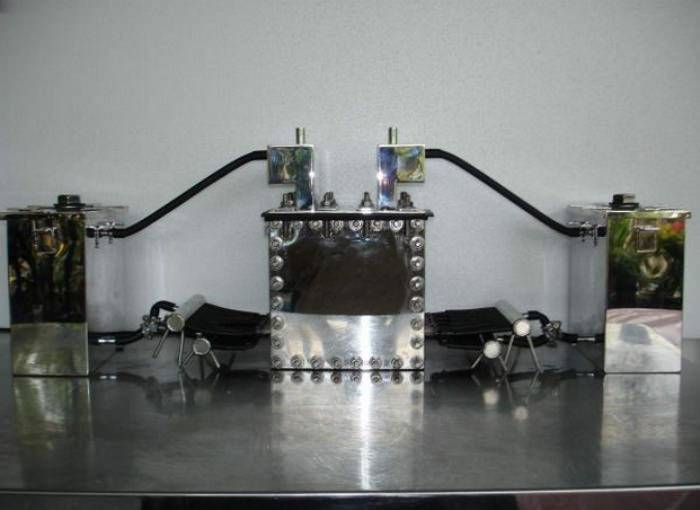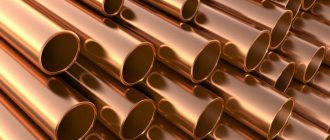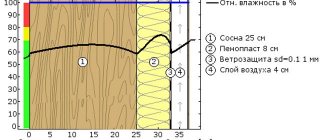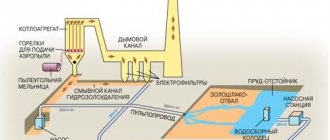Universal Gas Generator Brown HC12 / 24V-PRO
Instruction for installation and operation of the Brown Gas Generator - download ...
Application: Hydrogen generator (HHO generator) suitable for cars, vans, trucks, agricultural and construction equipment with engines from 1000 to 4000 cc. see. The hydrogen generator complies with the Bulgarian State Standard (BDS). It has been tested in a laboratory and underwent a conformity assessment procedure in accordance with Directive 2006/95-EC of the European Parliament. Marked with European conformity initials CE2024.
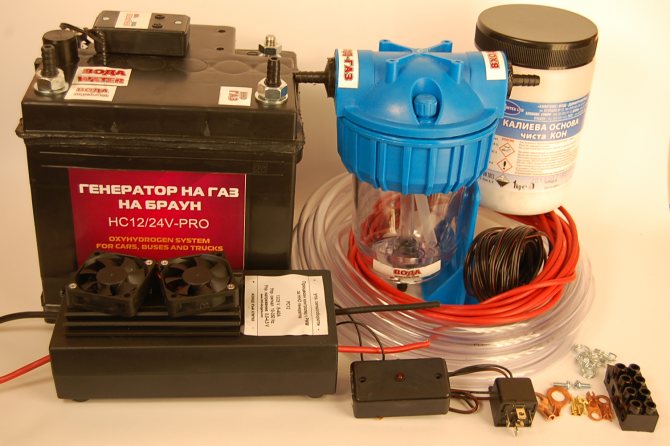
Brown Gas Generator
Operating voltage: 12 V - 14 V Power consumption: 10 A - 30 A Brown Gas production: 120 liters per hour. Fuel economy: 15% - 40% Electrolyte freezing temperature -25 degrees Celsius Warranty: 24 months (depending on operating conditions) All Brown Gas Generators manufactured by us are based on the HC12 / 24V Pro model. The modifications differ in input signals and sensors for registering control signals. Brown Gas Generator Package: 1 Hydrogen Cell 2. Magnetic Sensor (for Diesel Engines) / Inductive Sensor (for Gasoline Engines) 3. Water Filter / Expansion Tank 4. PWM Process Controller 5. Relay - 40A 6. Cables 7. Hoses 8. Electrolyte
Contacts - Order ...
Price list …
Discovery history
The fact that during a chemical reaction between acids and some metals a gas is formed, which is very flammable, is mentioned in treatises of the 16th century. This is what they called "combustible air". But to collect it in its purest form, study the properties and describe them only in the second half of the 18th century. So, chemist A. Lavoisier, conducting experiments in 1784, concluded that gas is a simple substance, consisting only of atoms of one type.
And the famous chemist and physicist G. Cavendish was able to experimentally determine that oxygen + hydrogen as a result of instant combustion gives water. By the way, one of the Cambridge laboratories is named in his honor precisely because he was able to determine the qualitative composition of water. The Latin name for hydrogen Hydrogenium comes from two words "hydro" - water and "gennao" - birth, that is, in it (as in the Russian version of the name of the element) its main property is described - to give birth to water.
Electrolyzers HC12 / 24V Pro
1. Operating voltage - 11-14.02 V 2. Load current 5 to 30 A 3. Operating temperature –15 to +50 degrees 4. Consumption current - level meter: - 5. Electrolyte concentration (KOH) - 10 - 14% 6. Gas Brown productivity up to 2 l / m. 7. Overall dimensions (mm): H = 220, L = 205, W = 175 8. Material 8.1. Box - polypropylene
8.2 Electrodes - Steel 316L


Brown Gas Generator
Electrolyzer - a device in which the electrolysis process is carried out electrochemically and as a result, Brown's Gas is released. The electrolyser box is made of polypropylene - a material with good resistance to temperature changes, vibrations, loads and aggressive chemical environment. It has the shape of a classic battery. Consists of box, top cover, fittings, valves and level meter. Inside are electrodes through which electrolysis is carried out. They are made from 316L steel. The electrodes are powered through stainless steel pins - A2 (grade 304). The assembly uses stainless steel washers and nuts. To improve the electrical conductivity outside the box, the nuts and washers, with which the cable glands for the electrolyser supply are pulled together, are made of ordinary galvanized steel. The electrolyzer is covered with stickers that indicate the purpose of the holes and fittings. The power terminals are marked with plus and minus and are directly imprinted on the plastic of the box. The electrolyzer also has an information sticker with the name of the product and information and coordinates of the manufacturer.The inscriptions are in Bulgarian and English.
Contacts - Order ...
Price list …
Homemade device
If you wish, you can learn how to independently obtain Brown's gas. It is easy to make a device for its production with your own hands. This requires the use of stainless steel plates, which should be cut into rectangles. In each sheet, at a distance of 3 cm from the edge, you need to make holes about 50 mm in size and solder the electrical cable.
Next, you need to prepare two square plexiglass plates measuring 20x20 cm (3 cm thick) and several rubber rings, the outer diameter of which will also be equal to 20 cm. Fixing holes should be provided in metal and glass sheets.
When all parts of the structure are ready, you can proceed to the assembly of the device. A rubber ring, pre-treated with a sealing compound, must be placed between the two steel plates, and everything must be bolted. Plexiglas sheets with holes for water inlet and gas outlet need to be attached to both sides of the resulting part. Tubes and fittings should be inserted into them.
In a home-made generator, it is imperative to make two water jams, otherwise the formed gas will begin to move in the opposite direction, which will lead to an explosion of the device. The tubes must be positioned so that one is completely submerged in water, and the other is above the liquid level and is directed towards the burner. In the course of liquid decomposition, the formed gas will move through them to water jams.
In order for the efficiency of a self-made heating device to be sufficient to heat a home, it is necessary to use it correctly. It is better to use distilled water and sodium hydroxide as a raw material. Before starting the device, apply soapy water to the plates, then wipe them with alcohol.
During electrolysis, a deposit will form on the walls of the generator and electrodes. It is best to remove it with sandpaper.
Process controller with PWM for NVO generator PC12
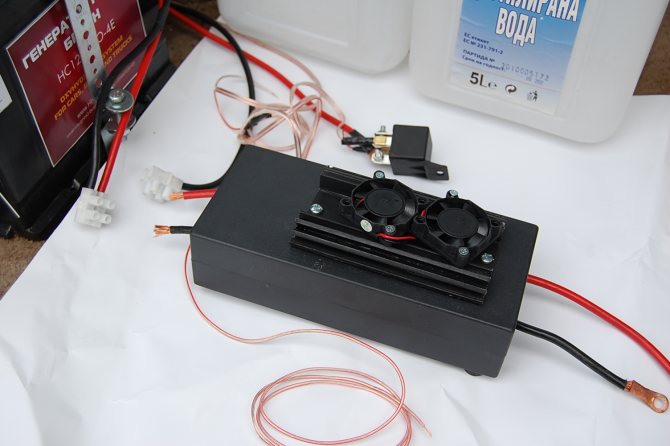

1. Working voltage 13/28 V 2. Working frequency - 1-3 kHz 3. Output current - <40A 4. Working temperature - from -15 to 80 degrees 5. Adjustment method - pulse width modulation 6. Control frequency. signal for speed control 10-350 Hz
7.Controlling ex. - 0.8 - 4.5 V 8. Box material - polystyrene 9. Dimensions (mm) - L = 199.4, H = 43.2, W = 84
Design features and device of the hydrogen generator
If there are practically no problems with the production of hydrogen now, then its transportation and storage is still an urgent task. The molecules of this substance are so small that they can penetrate even through the metal, which poses a certain safety risk. Absorbed storage is not yet highly profitable. Therefore, the most optimal option is to generate hydrogen immediately before its use in the production cycle.
For this purpose, industrial installations for the generation of hydrogen are being manufactured. As a rule, these are membrane-type electrolysers. A simplified design of such a device and the principle of operation are given below.
Legend:
- A - a tube for removing chlorine (Cl 2).
- B - removal of hydrogen (H 2).
- С - anode, on which the following reaction occurs: 2CL - → CL 2 + 2е -.
- D - cathode, the reaction on it can be described by the following equation: 2Н 2 О + 2е - → Н 2 + ОН -.
- E - a solution of water and sodium chloride (H 2 O & NaCl).
- F - membrane;
- G - saturated sodium chloride solution and the formation of caustic soda (NaOH).
- H - removal of brine and diluted caustic soda.
- I - input of saturated brine.
- J - cover.
The design of household generators is much simpler, since most of them do not produce pure hydrogen, but produce Brown's gas.So it is customary to call a mixture of oxygen and hydrogen. This option is the most practical, it is not required to separate hydrogen and oxygen, then you can significantly simplify the design, and therefore make it cheaper. In addition, the produced gas is burned as it is produced. Storing and storing it at home is not only problematic, but also unsafe.
Legend:
- a - a tube for removing Brown's gas;
- b - water supply inlet manifold;
- c - sealed housing;
- d - block of plates of electrodes (anodes and cathodes), with insulators installed between them;
- e - water;
- f - water level sensor (connected to the control unit);
- g - water separation filter;
- h - supply of power supplied to the electrodes;
- i - pressure sensor (sends a signal to the control unit when the threshold level is reached);
- j - safety valve;
- k - gas outlet from the safety valve.
A characteristic feature of such devices is the use of electrode blocks, since separation of hydrogen and oxygen is not required. This makes the generators quite compact.
"Process controller with PWM"
Process controller with PWM is a device that controls all processes occurring during the operation of the Brown Gas Generator. It regulates the amount of current depending on the mode in which the car's engine is at the moment. For example, at idle, the current taken from the alternator is 5-8 amperes, and at more than 2000 rpm it can be 18-30 amperes (depending on the engine size). The controller is controlled by signals that are generated by the car or by a sensor that monitors the speed of the car that we manufacture. We have two types of "Process controller" - operating at 12-14 volts and 24-28 volts. The regulator is controlled in several ways: - from the speed signal, which is taken from the car's alternator or from any sensor - for example, a crankshaft or camshaft, from an external sensor provided by us or from a frequency signal that is generated by induction from the voltage passing through any plug cable ignition of the car. This signal is applied to a thin cable that runs between two thick cables from the input side of the controller. On some Gasoline Vehicle Process Controllers, there is an output cable to which can be supplied as a voltage control signal from a TPS sensor located on the throttle valve. In principle, the signal there has a voltage of 0.8 to 4 volts. After applying this voltage, no controller settings are required - with this signal, it will work fine. After giving the appropriate signal, the Process Controller will start to work in a certain state according to the incoming signals. For fine tuning, you need to open the controller box and tune it according to your needs. This is done by moving
jumpers located on the motherboard. The controller supplies current of varying magnitude to the electrolyzer - in the range of 4-30 amperes. Process controller ”is placed in a plastic box. The “Process Controller” is designed so that it supplies current to the electrolyzer after starting the engine and starting charging the battery with a current of more than 13.2 volts. This is done in order not to load the alternator of the car at the beginning of work, so as not to take current from the battery and use only the free current produced by the alternator to obtain HHO gas. This function of the controller also acts as an overload protection - when many devices are switched on in the car, the voltage used to charge the battery drops and if the value falls below 13.2 volts, the controller turns off the Brown Gas Generator to prevent the generator from overloading.New Process Controllers which are made with a single-case microprocessor are configured by a computer using a programmer that we provide and software that we have developed.
Contacts - Order ...
Price list …
Project Charge
Comrades, we are continuing our exs with hydrogen. Description and discussion here.
Prospects for using the technology: - highly efficient gas cutting, gas welding; - significant fuel savings on vehicles (special attention to commercial vehicles, for example, truck tractors - owners of transport companies and just long-range trucks, this should be of great interest); - reduction of fuel consumption of power plants operating on liquid and gaseous fuels; - reconstruction of outdated boiler houses - the addition of NNO reduces consumption and makes the exhaust non-toxic; - heating at NVO; - creation of fundamentally new generators and engines.
We are dealing with an oxygen-hydrogen mixture, or HNO, or an explosive gas, or Brown's gas (some do not like this name, claiming that he attributed to himself the honor of discovering this gas, but nevertheless, there is such a name). This gas is obtained by electrolysis of water, i.e. in fact, fuel is around us in unlimited quantities, if we find a way to split water into components with minimal cost. This is what all the followers of Stanley Meyer and other legendary personalities are doing. It is difficult to judge the degree of success - basically these are the same videos, "secret schemes", endlessly copied and again laid out on the network, but sometimes something new appears. When trying to communicate with the "authors" of these technologies, some turn out to be scammers, some are schizophrenics, some simply do not know how to make elementary measurements, some vigilantly guard their secret. There is only one way out - we will go our own way)
What needs to be explained is that we can measure the gas output at the present time, and how much energy is contained in a unit volume of this gas is unknown until we get heat or mechanical work.
For example, here: you can find out the gross calorific value of hydrogen: 13,000 kJ / m3 (and for butane - 133,000!) Gross calorific value (Higher Calorific Value = Gross Calorific Value = GCV) - the amount of heat released during complete combustion of fuel, cooling products combustion to the fuel temperature and condensation of water vapor formed during the oxidation of hydrogen, which is part of the fuel.
That is, this is the heat released during the combustion of fuel in a certain ideal boiler, an ideal unattainable in practice. But, besides this, there is one more subtlety - the data are given for the combustion of fuel in the air, that is, a complex mixture of atmospheric gases, where oxygen is about 21%, and nitrogen is 78%. It is known that when pure oxygen is supplied, the flame temperature rises significantly. And NVO is a mixture of hydrogen and oxygen in ideal proportions for combustion, plus water vapor. Firstly, this very value of the gross calorific value for a given gas is unknown (if someone knows about such studies, please inform us about it), and secondly, it is not known how much water vapor is simultaneously produced in a particular device. For example, an "inventor" can build a "boiler" and be glad that he got a large gas output.
Upon receipt of the "rattlesnake". First, it is necessary to observe increased safety measures: - the mixture instantly detonates with a deafening pop and the release of energy, blowing everything to smithereens. therefore, no tanks and bubblers made of fragile plastic, which can give sharp fragments; - under no circumstances allow gas to accumulate in any container, immediately consume all the gas that is generated, and stop the lyser if there is no need for gas, or organize the gas outlet to the street; - do not install the electrolyzer in the basement, ensure the natural outlet of hydrogen upward, do not allow unventilated "pockets" under the ceiling.
The combustion of this gas also has its own peculiarities, it can be burned both in an open way and in a closed volume, because air supply is not required for the combustion of the non-commercial unit. We will try different options for both burners and hot water boilers.
There are a lot of rumors and even myths about the operation of the internal combustion engine at NGOs that need to be verified. The first step is to experimentally check how much the power developed by the internal combustion engine increases with the addition of NNO, and, accordingly, how much the main fuel supply can be underestimated to obtain the "standard" power. Naturally, the question arises of supplying the electrolyzer. The following methods are practiced: 1. Power the lyser from a generator driven by an internal combustion engine. this will require either an electrolyzer with a low power consumption (most of the commercially available NVO kits for cars), or replacing the generator with a more powerful one.In general, replacing a burned-out generator is a frequent case for such experiments, so be careful; 2. Installation of an additional generator operating only for the electrolyzer (for example, instead of an air conditioner). Here it is necessary to clarify whether the signal from the second generator will affect the on-board network, and in general the idea is interesting; 3. A more exotic way is to power the electrolyzer from a separate battery, and charge it while it is parked, a kind of hybrid option. This option is especially suitable for those who are interested in the topic, but who are confused by the energy balance - after all, the generation of current for the leaser takes away part of the ICE power. The official version of the technology supporters is this - yes, the power is taken away, but the addition of NNO significantly improves the combustion conditions of the fuel-air mixture, which increases the engine efficiency. In addition, the emission of harmful gases is significantly reduced, the internal combustion engine is cleaned of harmful deposits.
Along the way, problems arise with the engine management system, especially those equipped with a lambda probe (the probe shows an increased oxygen content in the exhaust gases, the control unit increases the fuel supply). Hence, as a result, various "tricks" of the lambda probe signal and other tricks arise. It is difficult to judge how effective such interventions are in the control system developed at the plant, one thing is clear - the simpler the engine, the easier and more effective the application of this technology. On the carburetor, fuel consumption, for example, is regulated by reducing the cross-section of the jet, but with electronics there are no problems at all. The owners of injection machines of the "dolambda era" were also incredibly lucky). In addition, on simpler engines, and especially on old, worn out, the effect of improved fuel combustion will be most pronounced.
In any case, the possibility of operating the internal combustion engine entirely on NVO seems unlikely, since the engines are designed for a specific type of fuel. A more likely option is to add gas in order to increase the efficiency of fuel combustion, reduce toxicity and consumption.
This concludes the introductory part, then our experiments and reports on them.
Synchronizer of signals of control mode "Process controller"
1.Input voltage: 12-14V 2.Output signal - voltage - 2-14V 3. Current consumption: This device is completely our development and represents a revolutionary discovery that increases the efficiency of the Brown gas generator by several levels and ensures accurate dosing of Brown Gas and delivery it to the engine.
The synchronization block serves to summarize and control signals with the help of which the two-stage operation mode of the “PWM process controller” is regulated. We take two types of signals from the engine - the signal of the engine operating mode (this signal shows in which mode the engine is currently operating) and the engine load signal (the signal indicates the engine load at the moment), process them in the device and generate a control signal for the Process Controller ”Which probably most adequately doses the amount of Brown's Gas that must be delivered for maximum efficiency. Hydrogen cell optimizer (Optimizer is a device whose role resembles the function of a turbine in an internal combustion engine).The Hydrogen Cell Optimizer is a unique device that: - improves the efficiency of the Brown Gas Generator by approximately 20%; -increases the productivity of the water cell up to 15%; -speeds up the transmission of Brown's Gas to the engine several times; -increases the dynamics of the engine running on Gas Brown; -Provides better assimilation of HHO gas by the engine; -decreases the temperature of the hydrogen cell; -increases safety; Recommended for vehicles with large engine displacement and used for professional transport activities - minibuses, buses, trucks, agricultural and construction equipment.
Contacts - Order ...
Price list …
Generator Benefits
The generator for producing Brown's gas has a rather simple device and an understandable principle of operation. Despite this, his use gives a number of significant advantages:
- The water required for its operation is available in almost unlimited quantities.
- Gas production is non-waste. The condensate formed during the electrolysis process turns into a liquid, which serves as a raw material for the formation of a new portion of fuel.
- The generated steam humidifies the indoor air.
- When water breaks down, no substances are formed that negatively affect human well-being.
A water generator will not be able to sufficiently heat a large home, but it will serve as an effective addition to other heating devices.
A device that generates gas from water is used not only in home heating systems. It is used successfully for the production of hydrogen automobile fuel and for metal welding... Some Western European enterprises that have introduced such devices in their production were able to abandon filters and air purification systems, since the process of melting and welding metals has become safer and more environmentally friendly.
The only significant drawback of Brown's gas production is the high energy consumption. The amount of consumed electricity is several times greater than the amount of heat received. Currently, specialists are working to reduce costs and increase the efficiency of the generating device.
Magnetic sensor - DN
(DU - sensor with increasing output voltage, DN-sensor with decreasing output signal)
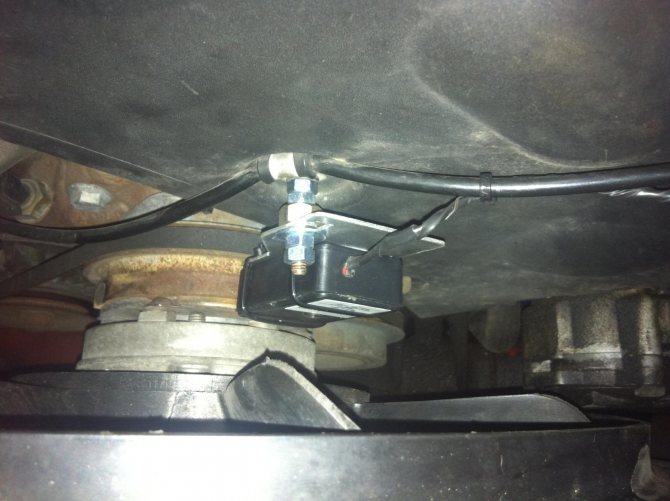

HHO generator sensor
1.Supply voltage: 12-14V 2.Output signal-voltage - 2-14V 3.Frequency of the output signal - 30 - 350 Hz 4. Current consumption: RPM sensor DU and DN is a device that registers the speed of the car engine and sends control signals to the "Process controller". A revolution sensor is a device that registers changes in a magnetic field with its sensing element. Opposite the sensor, magnets are attached to any of the engine pulley, which rotates in proportion to the revolutions of the crankshaft. As the magnets pass in front of the sensor, they change the magnetic field, and these changes are recorded by the sensor and generate frequency and voltage signals that control the process controller. The sensor is installed in a plastic box. A luminous indicator is installed on the cover of the sensor, which shows its operating mode. Powered directly from the vehicle battery to avoid confusion and power spikes when the vehicle is running.
Contacts - Order ...
Price list …
Application
Where is it used?


Interest in such an alternative fuel as hydrogen is growing. But the first developer to introduce a car that runs on such fuel was Toyota. However, his FCHV SUV remained an exhibition specimen, it was not mass-produced.Interest in hydrogen engines has not disappeared, so many manufacturers continue to invest large sums of money in the implementation of such an engine.
Oxyhydrogen gas, more precisely, hydrogen with oxygen supply, is used for welding and brazing metals in difficult conditions, such as tunnels and mines, manifolds and manholes, when there is simply no place for placing hydrocarbon cylinders. The combustion temperature of the mixture is approximately 2235 ° C, and the combustion products are absolutely safe for human health. The hydrogen burner has found its application in jewelry and denture, glass products, plates of expensive metals of various thicknesses, and more are processed with it.


Inductive spark plug control
The inductive sensor is designed to register the operating mode of gasoline engines by signals generated inductively from the plug cable of the car. Designed for gasoline engines. The cable of any candle is wrapped in a silicone cable in which a voltage is induced. The sensor registers this voltage as
frequency signal. The signal is converted into a voltage which controls the operation of the "Process controller". Thus, as the engine rpm increases, the production of Brown Gas is regulated, which is supplied to the engine.
1.Supply voltage: 12-14V 2.Output signal-voltage - 2-14V 3.Frequency of the output signal - 30 - 350 Hz 4. Current consumption: Level meter - LM1 1.Supply voltage: 12-14V 2. Current consumption:
Contacts - Order ...
Price list …
Enemy of the miners
Sometimes the term "oxyhydrogen gas" is mistakenly used for methane. The ability of this hydrocarbon to accumulate in the voids of rocks and, when mixed with air, becomes explosive, it is similar to a mixture of real gas, but this is where their similarity ends. The formula for a gas in chemistry looks like this: CH4.
The most dangerous concentration of methane in the atmosphere is 9.5%, but under different conditions it can vary from 5 to 16%. At a higher concentration, the gas will simply burn. An explosion can be provoked by both a spark and an open fire. To control the concentration of methane in the air, the miners took a canary with them, and they knew that while the song of a little friend was being heard, they could work in peace. But as soon as the bird fell silent, it meant that trouble was near.
At the beginning of the 19th century, the singers were replaced by the Davy miner's lamp, and today the control is carried out by an automatic system, but this does not make the work of miners completely safe. Explosions sometimes happen even now. Here it is so terrible - "mine gas".
What is needed to make a fuel cell at home
When starting to manufacture a hydrogen fuel cell, it is imperative to study the theory of the process of oxyhydrogen gas formation. This will give an understanding of what is happening in the generator, help in setting up and operating the equipment. In addition, you will have to stock up on the necessary materials, most of which will be easy to find in the retail network. As for the drawings and instructions, we will try to disclose these issues in full.
Hydrogen generator design: diagrams and drawings
A home-made installation for producing Brown's gas consists of a reactor with installed electrodes, a PWM generator for their power supply, a water seal and connecting wires and hoses. Currently, there are several schemes of electrolysers using plates or tubes as electrodes. In addition, a so-called dry electrolysis plant can be found on the Internet. Unlike the traditional design, in such a device, not the plates are installed in a container with water, but the liquid is supplied to the gap between the flat electrodes. Rejection of the traditional scheme allows to significantly reduce the size of the fuel cell.
Electrical diagram of the PWM regulator Diagram of a single pair of electrodes used in the Meyer fuel cell Diagram of the Meyer cell Electrical diagram of the PWM regulator Drawing of the fuel cell Drawing of the fuel cell Electrical diagram of the PWM regulator Electrical diagram of the PWM regulator
In the work, you can use the drawings and diagrams of working electrolysers, which can be adapted to your own conditions.
Selection of materials for the construction of a hydrogen generator
Almost no specific materials are required to make a fuel cell. The only thing that can be difficult is the electrodes. So, what needs to be prepared before starting work.
- If the design you have chosen is a "wet" type generator, then you will need a sealed container for water, which will simultaneously serve as the reactor vessel. You can take any suitable container, the main requirement is sufficient strength and gas tightness. Of course, when using metal plates as electrodes, it is better to use a rectangular structure, for example, a carefully sealed case from an old-style car battery (black). If tubes are used to obtain HHO, then a capacious container from a household filter for water purification is also suitable. The best option would be to make a stainless steel generator housing such as 304 SSL.
Electrode assembly for a wet-type hydrogen generatorWhen choosing a "dry" fuel cell, you will need a sheet of plexiglass or other transparent plastic up to 10 mm thick and O-rings made of technical silicone.
- Stainless steel tubes or plates. Of course, you can take the usual "ferrous" metal, however, during the operation of the electrolyzer, simple carbon iron quickly corrodes and the electrodes will have to be changed frequently. The use of a high-carbon metal alloyed with chromium will enable the generator to operate for a long time. Craftsmen involved in the manufacture of fuel cells for a long time were engaged in the selection of material for the electrodes and settled on stainless steel grade 316 L. By the way, if tubes from this alloy are used in the design, then their diameter must be selected in such a way that when installing one part in the other, there was a gap of no more than 1 mm between them. For perfectionists, here are the exact dimensions: - outer tube diameter - 25.317 mm; - the diameter of the inner tube depends on the thickness of the outer one. In any case, it must provide a gap between these elements equal to 0.67 mm.
Its performance depends on how accurately the parameters of the parts of the hydrogen generator are selected. - PWM generator. A properly assembled electrical circuit will allow you to adjust the frequency of the current within the required limits, and this is directly related to the occurrence of resonance phenomena. In other words, in order for the evolution of hydrogen to begin, it will be necessary to select the parameters of the supply voltage, therefore, special attention is paid to the assembly of the PWM generator. If you are familiar with a soldering iron and can tell the difference between a transistor and a diode, then you can make the electrical part yourself. Otherwise, you can contact a familiar electronics engineer or order the manufacture of a switching power supply in an electronic device repair shop.
A switching power supply designed for connection to a fuel cell can be purchased on the Internet. Small private companies in our country and abroad are engaged in their manufacture.
- Electrical wires for connection. It will be enough conductors with a cross section of 2 sq. mm.
- Bubbler. The craftsmen called this fancy name the most common water seal. Any sealed container can be used for it.Ideally, it should be equipped with a tight-fitting lid, which, if the gas inside ignites, will instantly be torn off. In addition, it is recommended that a cut-off device be installed between the electrolyzer and the bubbler to prevent the HHO from returning to the cell.
Bubbler design - Hoses and fittings. To connect the HHO generator, you will need a transparent plastic tube, inlet and outlet fittings and clamps.
- Nuts, bolts and studs. They will be needed to attach the parts of the electrolyzer to each other.
- Reaction catalyst. In order for the process of HHO formation to proceed more intensively, potassium hydroxide KOH is added to the reactor. This substance can be bought on the Internet without any problems. For the first time, no more than 1 kg of powder will be enough.
- Automotive silicone or other sealant.
Note that polished tubes are not recommended. On the contrary, experts recommend sanding the parts to obtain a matte finish. In the future, this will help increase the productivity of the installation.
Tools that will be required in the process
Before you start building a fuel cell, prepare the following tools:
- hacksaw for metal;
- drill with a set of drills;
- set of wrenches;
- flat and slotted screwdrivers;
- angle grinder ("grinder") with an installed wheel for cutting metal;
- multimeter and flow meter;
- ruler;
- marker.
In addition, if you are going to build a PWM generator yourself, you will need an oscilloscope and a frequency counter to set it up. Within the framework of this article, we will not raise this issue, since the manufacture and configuration of a switching power supply is best considered by specialists in specialized forums.
Pay attention to the article, which lists other sources of energy that can be used to equip home heating:
